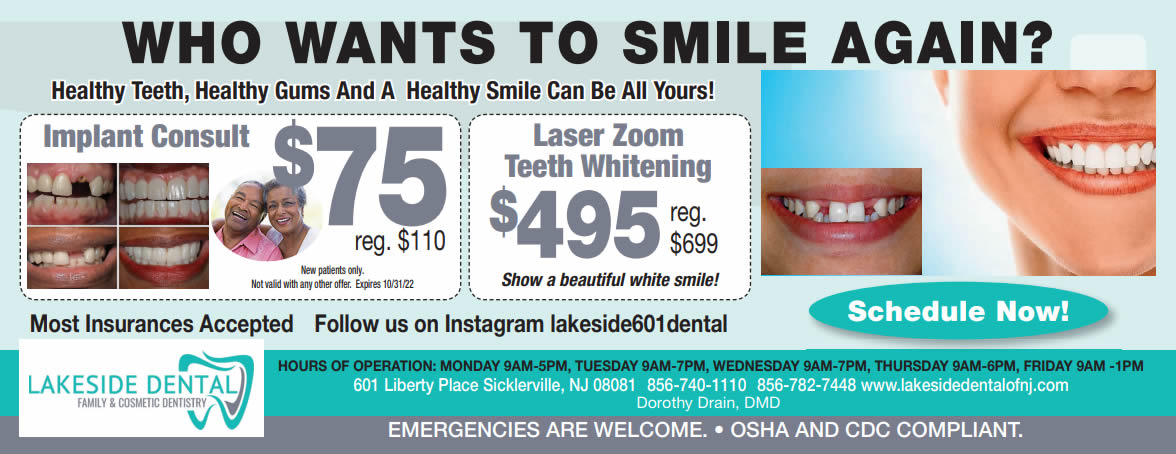
Straight, white smiles are in high demand, and choosing who is going to perform your smile makeover is not a decision to be taken lightly. The American Dental Association does not include cosmetic dentistry as one of the eight specialties, meaning there are no legal restrictions against any dentist calling themselves a “cosmetic dentist.” Therefore, it is vital to the success of your treatment to do research and find the best cosmetic dentist to perform your smile makeover. When searching for a qualified cosmetic dentist, consider the following:
- Ask your potential dentist about their cosmetic studies. Beyond dental school, a trained cosmetic dentist should have taken postgraduate courses and training in the particular types of procedures you are seeking.
- Find out what organizations they belong to that focus solely on cosmetic dentistry. The American Academy of Cosmetic Dentistry is the most notable, and offers an accreditation program that includes extensive continuing education and rigorous testing to ensure outstanding skills. Dentists who complete this accreditation are considered to be the very best in their field.
- Ask to see “before and after” photos of patients they have treated for smile makeovers. It is important you like the style and quality of the work shown in the photos before moving forward with your chosen cosmetic dentist.
- Inquire about testimonials and reviews from patients who have been treated for cosmetic problems similar to yours. An internet search can also yield information and reviews from previous patients about the cosmetic dentist you are considering.
- Find out how long the cosmetic dentist has been practicing and which cosmetic dental procedures they most commonly perform.
- Ask about the technology in their office. Current dental technology is one way to determine the level of advanced care in a cosmetic dentistry practice.
- Is the dentist and office staff friendly, helpful, and knowledgeable?
Be sure you feel comfortable and confident with your choice of a cosmetic dentist before proceeding with a smile makeover. Making the best choice can mean enjoying years of a beautiful, bright smile.
We treat patients from Sicklerville and the surrounding area

Porcelain veneers have become a popular option in the past few years for dental patients who wish to brighten and repair their smile. While traditional porcelain veneers offer a lifelike quality and excellent durability, their placement usually requires the removal of some of the tooth surface enamel, which is an irreversible procedure.
A promising solution for patients who wish to avoid altering the tooth structure are no-prep or minimally invasive veneers. No-prep veneers offer the same advantages of traditional veneers but eliminate or reduce the need to grind, cut, or file down the teeth.
Lumineers are one of the most popular of the “no-prep” variety of veneers. Lumineers use an extremely thin veneer that is placed on the front side of your teeth. The placement of Lumineers does not require the modification of the natural tooth structure or the use of temporary veneers. Lumineers produce beautiful smiles for patients who prefer to not physically alter their teeth.
DURAthin veneers are similar to Lumineers in that they require no modification of the tooth structure or filing of the enamel. DURAthin veneers utilize very thin customized porcelain shells that match the shape and color of your teeth. These shells are roughly the width of a contact lens and are bonded to the front of your teeth. Because of their size and shape, DURAthin veneers are an ideal choice for correcting minor cosmetic dental issues.
Vivaneers are among the thinnest veneers available, making them easy to apply in as little as one office visit. Because they require no preparation to your natural tooth, there is no need for shots, drilling or anesthesia. If you are unhappy with the results, Vivaneers are easily reversible.
To find out if these or other “no-prep” veneer options would be a solution for improving your smile, schedule a consultation with a Sicklerville cosmetic dentist Dr. Drain .

Keeping your teeth and gums in good condition can mean the difference between being embarrassed to smile and being happy to display your pearly whites. Your smile is one of the first things people notice, so here are some things to add to your dental care routine so that your teeth are sparkling and healthy.
Brush after consuming staining items:
Avoid foods and drinks that are known to stain your teeth, such as coffee, red wine, colored gravies, and dark colas. Brush your teeth as soon as possible after consuming such items. If brushing isn’t possible, try eating an apple to help clean away staining residue.
Change your toothbrush:
Old bristles that are out of shape and worn harbor bacteria and don’t as good of a job as newer brushes. Change your toothbrush every three months, or when it starts to look worn. Remember to choose a brush with soft bristles for the best treatment of your teeth and gums.
Floss regularly:
Use dental floss at least once every day to clean between your teeth and along your gums. Carry floss with you so that you can quickly use it in private moments after a meal or bothersome snacks.
Use mouthwash:
Add mouthwash to your daily routine to help kill bacteria that your toothbrush doesn’t reach. It also can help improve your breath.
See your dentist:
No matter how well you care for your mouth, see your dentist every six months for checkups and professional cleanings. This will not only keep your teeth bright, it will catch any problems early in hopes of avoiding more extensive dental work in the future.
If you live in the Sicklerville area contact us today

Denture technology has come a long way since the days of George Washington and his wooden teeth. Unfortunately, people still lose teeth for a variety of reasons including periodontal disease, trauma, and decay. Missing teeth make talking and eating difficult, and can ultimately cause sagging facial muscles. However, with today’s advances in technology it is more possible than ever to replace those lost teeth with natural and comfortable dentures.
Complete dentures cover both upper and lower jaws. The options for complete dentures range from immediate dentures to highly customized implant dentures. Immediate dentures are pre-made and available at your dentist’s office. They are not custom fitted and are set into gum sockets immediately upon removal of your teeth. While these offer the convenience of walking immediately out of the dental office with your new teeth in place, once gum tissue heals and swelling reduces they may shift and become loose. This issue requires follow-up visits for your dentist to make adjustments. People with immediate dentures may also have difficulty speaking, or experience a “clicking sound” when talking.
Conventional full dentures can be made 8 to 12 weeks after tooth loss or removal. Once the gums have healed, your dentist takes a series of impressions of your mouth to be sent away to a dental lab to create your dentures. This process may require multiple visits to your dentist to ensure a proper fit and correct bite. While this process takes longer and is more involved than immediate dentures, you will achieve a more secure and personalized fit. Both conventional and immediate dentures require the use of denture adhesives to keep them securely in place.
For an even more custom, natural looking and secure denture option, implant dentures are an excellent alternative. With implant dentures, small implants are placed in the jaw where they heal in place surrounded by the bone. The denture then snaps into the implant with attachments under the denture. These attachments keep the denture stable, providing more comfort and confidence. You do not have to worry your dentures will slip or fall out while you are eating, talking, or laughing. Implant dentures do not require the use of any denture adhesives.
Talk to your dental professional to determine the best use of denture technology to ensure many years of a confident and comfortable smile.
We look forward to seeing you in our Sicklerville dental office

Why wait until you have a toothache, bleeding gums, bad breath, or other problems to decide it’s time to start focusing on your oral health? Your mouth and your whole body can benefit from maintaining good oral health. Here is some simple advice that will help you along the path to a healthy smile.
Brushing and flossing
Tooth decay and gum disease are both preventable with proper brushing and flossing. Brush with a soft-bristled toothbrush and fluoride toothpaste, using a circular motion. It’s best to brush after every meal, but twice a day should be the minimum. Gently floss your teeth daily to remove food particles and bacteria between your teeth.
Eating right
Focusing on eating foods from each food group will aid your oral health in addition to your overall health. Not getting essential nutrients in your diet increases your risk of gum disease, and also makes it more difficult for your body to resist infection. Eat low fat dairy items, lean proteins, vegetables, fruits, and whole grains. Look for foods low in sugar, which can lead to tooth decay. Avoid snacking too much during the day when you aren’t going to brush your teeth afterwards, and drink plenty of water throughout the day.
Seeing your dentist
Visit your dentist at least twice a year for checkups. During these appointments, your dentist will look for problems and professionally clean your teeth. Delays in treatment of some conditions can cause them to worsen to the point that treatment may be more painful, difficult, or costly. Your dentist will help you keep your teeth and gums healthy so that you can keep smiling as long as possible.
If you live in the Sicklerville area contact us today

In the past, replacing lost teeth meant getting dentures or bridges. Even though these offered the best way at the time to restore your mouth’s appearance and function, technology has improved through the development of dental implants. The main drawbacks of bridges and dentures is that they do not feel or look just like real teeth, and it is difficult to chew tough foods. The advantage of implants is that they look and perform so well that you can’t even tell they are not your natural teeth.
Made from titanium, dental implants are screws that are surgically placed directly into your jawbone. They are light and malleable, but durable and strong. The titanium screws are implanted into your jawbone and given time to heal. Once healing is complete, one or multiple crowns are placed on top of the implant to recreate your missing teeth. One implant can hold more than one screw, so it is possible to attach as many crowns as needed to replace your missing teeth.
Dental implants look so much like real teeth that others won’t even be able to tell that you have any artificial teeth. You might even forget about it yourself, as they feel real as well. Since the implants are securely placed in your jaw, they are as strong as real teeth and you are able to chew and bite anything that you would normally eat. Another great thing about implants is that they don’t impact any of your adjacent healthy teeth. While bridges and dentures can sometimes damage neighboring teeth because those teeth are necessary for support, implants avoid this problem. You are left with a fully restored and comfortable smile.
If you live in the Sicklerville area contact us today












